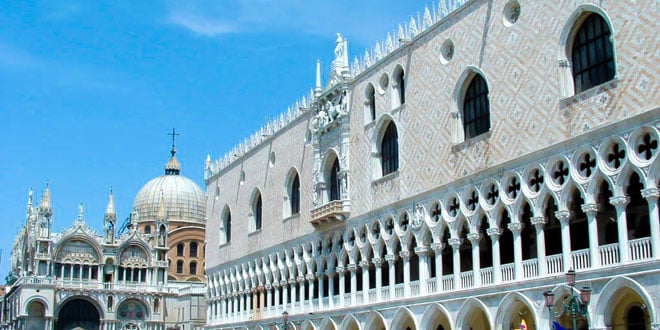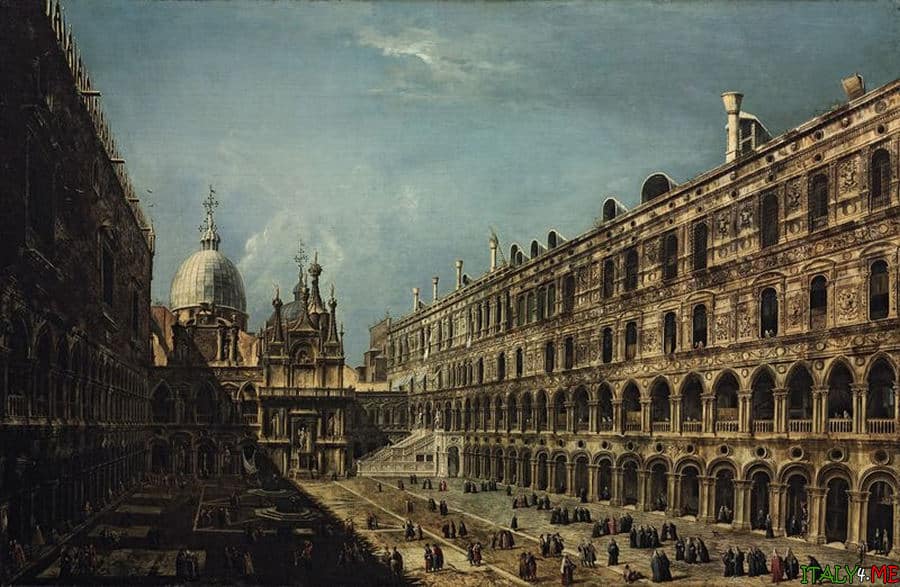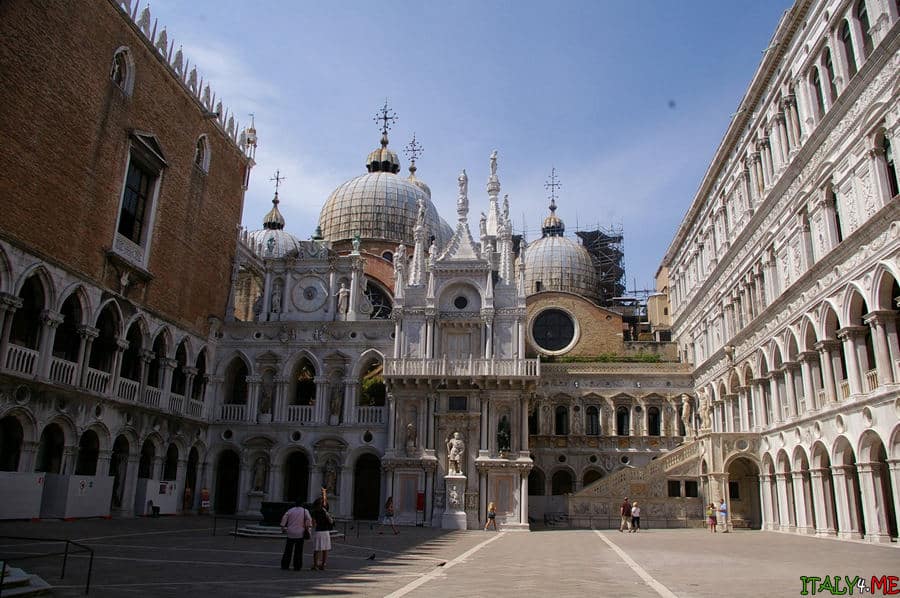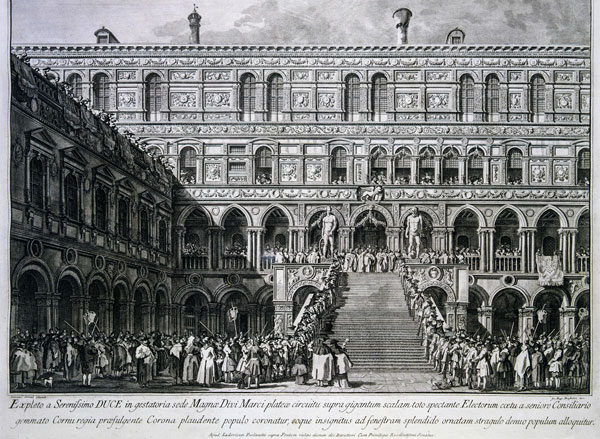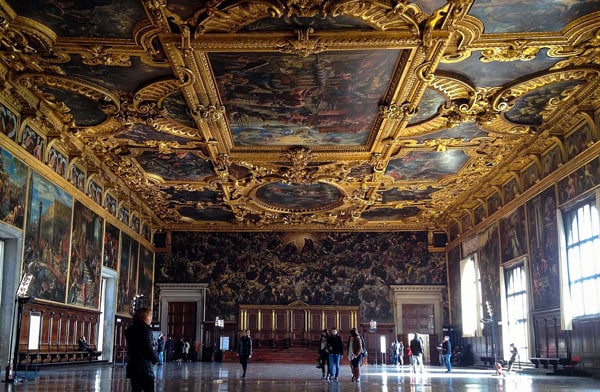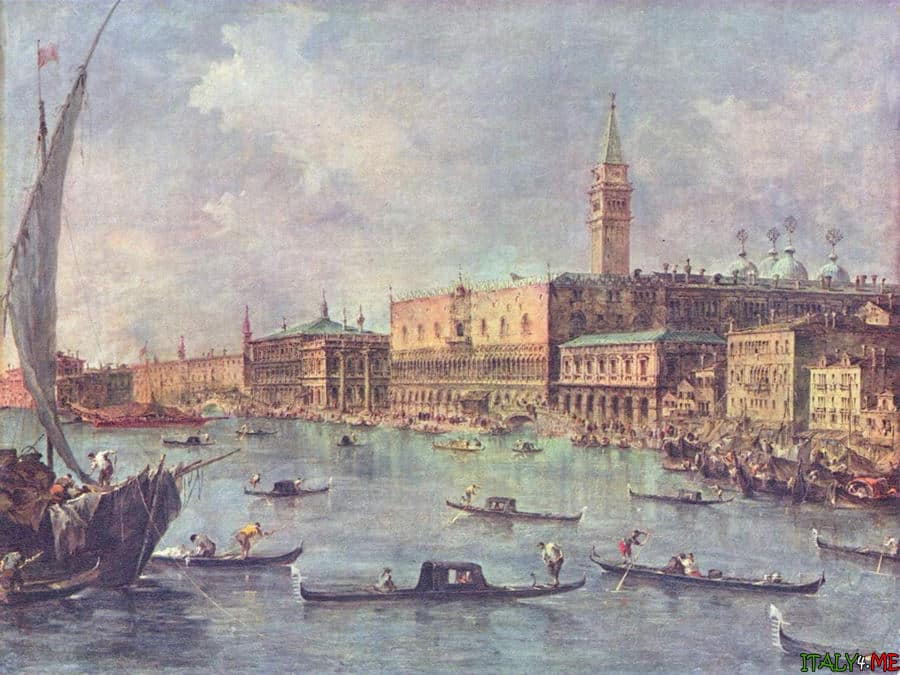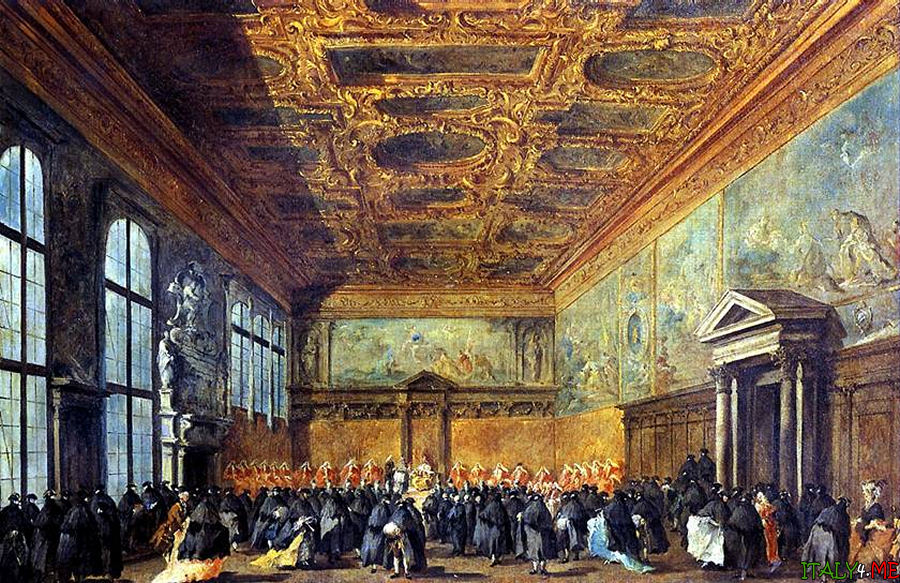The Doge’s Palace, also known as Palazzo Ducale, is the main attraction of Venice, an architectural monument of Italy, designed in the Gothic style. The project’s architect was Filippo Calendario (Calendario).
Page Contents
History of Construction
The construction of the Palace took place over 115 years, from 1309 to 1424. In 1577, a fire significantly damaged the building. The Palace was restored in the old style, despite the dawn of Renaissance architecture. The building was the residence of the doges. The Doge was the head of the government of the Venetian Republic, who was elected for life through a multi-stage voting process.
Candidates for the position of the Doge came from the most influential families of Venice. The institution of the doges lasted for over a thousand years until Napoleon abolished it in 1797.
In addition, the Senate, the Great Council, the Collegio, the Supreme Court, the maritime department, the secret police, and other representatives of the state apparatus convened in the Palace. The Doge’s Palace stands out from its contemporary palaces because it is not a fortress.
Who Was Located Within the Walls of the Doge’s Palace
Despite its name, the Doge’s Palace served not only as the residence of the rulers of the Republic of Saint Mark. The personal apartments of Venice’s head occupied only the building’s northern wing. Meetings of the Great Council and the Senate members were also held in the Palazzo.
Here, hearings of the Supreme Court took place, and the secret police and the Inquisition operated. There were legal offices, a chancellery, the maritime department, and other municipal institutions on the first floor. Thus, the Doge’s Palace was the home of the government of Venice, a fantastic city-state that did not have a singular authority for several centuries of its vibrant history.
Tickets, Tours, and Opening Hours
Within the Palazzo’s ancient walls, a museum is open to visitors daily. Guests are offered to see the Doge’s Palace halls’ stunning decor independently or as part of guided tour groups. Visiting the secret chambers of the Doge’s Palace and the prison located on the upper floor of the building is not included in the main tour program and is charged additionally.
Schedule from April 1 to October 31:
- Sunday – Tuesday, 8:30 AM – 9:00 PM;
- Friday – Saturday, 8:30 AM – 11:00 PM.
Schedule from November 1 to March 31:
- Every day of the week, 8:30 AM – 7:00 PM.
If you are fluent in English, Italian, French, Spanish, or German, I recommend booking a tour for 42 euros per person, which includes the ticket.
Who Resided Within the Walls of the Doge’s Palace
Despite its name, the Doge’s Palace served not only as the residence of the rulers of the Republic of Saint Mark. The personal apartments of Venice’s head occupied only the building’s northern wing. The Palazzo also hosted meetings of the Great Council and the Senate members.
Hearings of the Supreme Court were conducted here, and the secret police and the Inquisition operated as well. There were law offices, a chancellery, the maritime department, and other municipal institutions on the first floor. Thus, the Doge’s Palace was the home of the Venetian government, a remarkable city-state that knew no singular power over several centuries of its vibrant history.
Tickets, Tours, and Opening Hours
Today, a museum operates within the ancient walls of the Palazzo, open to visitors daily. Guests can explore the stunning decor of the Doge’s Palace halls on their own or as part of guided tours. Visiting the secret chambers of the Doge’s Palace and the prison located on the upper floor of the building is not included in the main tour program and requires an additional fee.
Schedule from April 1 to October 31:
- Sunday – Tuesday, 8:30 AM – 9:00 PM;
- Friday – Saturday, 8:30 AM – 11:00 PM.
Schedule from November 1 to March 31:
- All days of the week, 8:30 AM – 7:00 PM.
If you speak English, Italian, French, Spanish, or German, I recommend booking a tour for 42 euros per person, which includes the ticket.
For particularly inquisitive tourists, I suggest paying attention to the tour that includes secret routes and rooms not accessible to ordinary visitors. This tour costs 54 euros, is available only by prior reservation, and starts at 08:30 or 09:00.
Official website: palazzoducale.visitmuve.it – here, those wishing to visit the Palace independently can order tickets online for 26 euros to avoid standing in lines. A reduced ticket price of 15 euros is available for holders of special tourist cards, children aged 6 to 14, and students aged 15 to 25 with an ISIC card. A document proving age and eligibility for the discount must be presented.
The Structure of the Doge’s Palace
The Palace is a three-story building shaped like a “П,” made of gray, white, and pink marble. The building has two facades forming a right angle.
The first floor features a gallery of upward-pointing arches supported by columns.
The second floor is also formed by columns, but they are thinner and taller, with a series of lodges at the top decorated with quatrefoil ornaments.
The third floor is a smooth wall clad in white marble, pierced by large and small windows. On the south facade, there is a balcony, which served as the Doge’s tribune. Above the balcony is a monument to Justice by Alessandro Vittoria.
The wall around the perimeter is crowned with intricate white marble battlements. The Palace has two main entrances:
- Porta della Carta, the paper gate;
- The ceremonial entrance to the Doge’s Palace.
Above the gate, there is an image of the winged lion of Saint Mark, with Doge Francesco Foscari kneeling before it. The paper gate got its name from the tradition of posting announcements on it.
Porta del Frumento, the wheat gate, leads to the promenade and is the starting point for tours of the Palace.
The Giants’ Staircase
The tour of the Doge’s Palace halls begins for tourists in the inner courtyard. The ceremonial Giants’ Staircase (Scala dei Giganti), made of the finest marble brought specially to Venice from the Apuan Alps (Alpi Apuane), leads to the second floor.
It is named after the huge stone statues of Mars and Neptune (Marte e Nettuno), erected in 1554 at the top of the structure. The author of these sculptures, symbolizing the might of the “Queen of the Adriatic,” as Venice was once called, is Jacopo Sansovino, a celebrated master of the High Renaissance era.
For several centuries, one of the Republic of Saint Mark’s most solemn and lavish ceremonies—the inauguration of the newly elected Doge—took place on the terrace crowning the Giants’ Staircase. The new ruler received a special headgear, the ducal cap (Corno Ducale), symbolizing power, from the chief member of the Council.
After ascending the Giants’ Staircase, guests of the Doge’s Palace enter a covered gallery. Like other rooms in the Palazzo, its walls are adorned with relief images of menacing lion’s mouths (bocca di leone).
The Great Council Hall
The most impressive room in the Doge’s Palace is the Great Council Hall (Sala del Maggior Consiglio), located on the second floor of the Palazzo. It occupies the entire southern wing of the building. Here, governmental meetings of the central authority, which discussed the primary issues of internal and external policy, were held.
The vast size of the room (14,531 square feet) was necessitated by the number of members of the Great Council, who gathered to discuss important state affairs, ranged from 1,000 to over 2,000 individuals at different periods of the Venetian Republic’s existence. The hall, one of the largest in Europe, features an extraordinary architectural characteristic. Despite the walls being 49 feet high, there are no columns or supports, and the ceiling is held up by a unique system of attaching the rafters to the beams.
The interior is adorned with masterpieces by leading masters of the Venetian school of painting, such as Titian, Paolo Veronese, Tintoretto, and many others. A devastating fire in 1577 almost destroyed the decorative finish of the walls and ceiling, but many great artists participated in the restoration works. The restoration was overseen by the famous architect and engineer Antonio da Ponte. The hall houses an extensive collection of portraits of Venetian doges, arranged in chronological order, except for the 55th ruler of the Republic of Saint Mark, Marino Faliero, who was stripped of his title and sentenced to death for attempting a coup. The sequence of state leaders’ images continues in the adjacent Hall of the Scrutiny.
The monumental painting “Paradise” by the 70-year-old Tintoretto enhances the room’s grandeur. The great master and his pupils worked on this extensive piece (23 x 72 feet) for about 13 years. It adorns the wall with a pedestal where the Doge and six members of the Minor Council once sat. This captivating painting, striking in its unusual color scheme, complexity of composition, and depth of allegorical meaning, is considered the largest oil painting in the world.
The Scrutinio Hall
On the second floor of the Doge’s Palace is also the Scrutinio Hall (Sala dello Scrutinio) or Hall of Voting. Initially, it was a storage place for books and manuscripts. In 1469, Cardinal Bessarion, a true connoisseur and advocate of classical literature, donated his precious collection, which included hundreds of manuscripts and printed editions in Latin and Ancient Greek, to the Venetian Republic. These literary treasures, bequeathed by one of the greatest enlighteners and humanists of the 15th century, formed the basis of the Marciana Library, built several decades later.
From 1532, the Scrutinio Hall became the venue for balloting officials into the highest state positions. It was also here that the complex, multi-stage process of electing the Venetian doges took place. The public voting process often ended in indictments, so those present were prohibited from carrying weapons.
The walls and ceilings of the Hall of Scrutinio impress with their richness and pompous decor. Besides large-scale paintings that narrate the centuries-old military prowess of the Republic of Saint Mark, the grand painting “The Last Judgment,” adorning the southern part of the room, deserves special attention. Its author is Jacopo Palma il Giovane, a prominent figure in the Venetian school of painting.
Another striking decorative detail is the sizable Triumphal Arch, erected at the Senate’s initiative to honor the brave Venetian Doge Francesco Morosini, who became famous for his brilliant victories in the Great Turkish War.
The Armorial Hall (or The Map Room)
The Armorial Hall (Sala dello Scudo), located on the second floor of the Palazzo, was part of the Doge’s private apartments (Appartamento Ducale). The city-state ruler held audiences for palace guests here. This distinctive reception room got its name not by chance. The coat of arms belonging to the ruling Doge’s family hung on the central wall, framed by a massive, gilded shield.
The hall is adorned with two ancient globes (17th century) and huge geographical maps created by the Italian writer-traveler Giovanni Battista Ramusio and the naturalist Francesco Griselini.
The Scarlet Room
The Scarlet Room (La Sala degli Scarlatti) is next to the Doge’s chambers. It served as a special room where high-ranking officials gathered and waited for the state ruler to come out for ceremonial events.
The luxurious interior decoration was supervised by the sculptor and architect Pietro Lombardo. The main element of the decor is a wooden carved ceiling with exquisite patterns covered in gold leaf. The walls are adorned with elegant bas-relief compositions. A massive fireplace made of pristine white marble gives the room solemnity and grandeur. At its top is the family coat of arms of the 74th Venetian Doge, Agostino Barbarigo.
The Grimani Hall
The magnificent Grimani Hall (Sala dello Grimani) was once among the few rooms belonging to the doges. It was named after the wealthiest and most powerful Venetian clan, which gave the Republic of Saint Mark three rulers. The wise policies of the influential family members earned them the genuine love and respect of ordinary people. Thus, Venetians rejoiced and celebrated for several days, marking the inauguration of the 89th Doge, Marino Grimani.
The family coat of arms is at the center of the hall’s ceiling, while the walls are decorated with canvases featuring the winged lion of Saint Mark – the main symbol of the “city on the water.” The most famous work is the eponymous painting by Vittore Carpaccio, depicting the Old Testament beast against the backdrop of the lagoon, victorious ships, and the Doge’s Palace itself.
The Golden Staircase
The covered gallery on the second floor of the Doge’s Palace leads to the Golden Staircase (Scala d’Oro), which provides access to the Palace’s inner chambers on the third tier. Only high-ranking guests and titled citizens holding important state positions were allowed access here during the Venetian Republic. The names of these aristocrats were immortalized in the “Golden Book” (Libro d’Oro), with entries dating back to 1315.
The staircase, elegantly decorated with luxurious stucco work, marble sculptures, and bas-reliefs, was designed in 1538 by Jacopo Sansovino and realized nearly 20 years later through the efforts of the renowned architect Antonio Abbondi.
The Hall of the Four Doors
Upon reaching the third floor, the bright, spacious Hall of the Four Doors (Sala della Quattro Porte) is the first room visitors enter. It served as a waiting room for those wishing to meet with Collegio, the Senate, and the Council of Ten members.
Marble columns and elegant sculptural groups adorn the massive bronze doors. The luxurious stucco work on the ceiling, crafted by Giovanni Cambi, is striking in its intricacy and elegance. The hall features magnificent frescoes and paintings by Jacopo Tintoretto, Titian, and Giovanni Battista Tiepolo, which allegorically narrate the grandeur of the Republic of Saint Mark.
The Anticollegio Hall
The Anticollegio Hall (Sala dell’Anticollegio) is a true treasure trove of masterpieces created by artists in the second half of the 16th century. This smaller room once served as a waiting area for foreign ambassadors and high-ranking individuals from other states. The mythological themes of the paintings embody the wisdom of Venetian rulers. One of the most famous artworks is “The Rape of Europa” by Paolo Veronese.
The room is decorated with a splendid fireplace adorned with marble statues of atlantes, intricate sculptural groups, and rhythmic ornaments. The celebrated architect Andrea Palladio designed the luxurious interior and is considered the progenitor of Italian classicism.
The Collegio Hall
Within the magnificent Collegio Hall (Sala del Collegio) walls, critical national and foreign policy issues of the Venetian Republic were addressed. The administrative, consultative, and executive body included several members, primarily the Doge and his six counselors, known as “wise men.” Important decisions were also made with the participation of the Cancelliergrande, essentially the second most important person in the state, and the heads of the Council of Ten. Here, meetings with foreign delegations were held, and draft laws were formulated, later awaiting approval by the Senate.
The walls of the Collegio Hall are adorned with 11 skillful paintings by Venetian masters, framed in massive gilded frames. The ceilings feature allegorical frescoes by Paolo Veronese, including the remarkable “Venice Enthroned with Justice and Peace,” distinguished by its high execution technique and profound symbolism.
The Senate Hall
The Senate Hall (Sala del Senato) served as the venue for meetings of the oldest governing body, established in the first quarter of the 13th century. By the 16th century, this governmental entity had nearly 300 representatives, all holding elected positions. Senators, distinguished from other Venetian patricians by their crimson robes, managed financial, trade, and diplomatic matters and crucial issues concerning the army and navy.
The luxurious interior of the hall, adorned with paintings and gilded stucco, features an exciting detail: walls decorated with ancient clocks with unusual dials. One set of hands shows the position of the Sun in the zodiac signs, while the other indicates the time based on 24 Roman numerals. Particularly noteworthy is Tintoretto’s monumental painting “The Triumph of Venice, Queen of the Seas,” located in the central ceiling panel, captivating viewers with its intricate design, vibrant colors, and dynamic composition.
The Compass Room
The commonly misunderstood name of the Compass Room (Sala della Bussola) has nothing to do with the navigational instrument.. The word “bussola” can mean “compass” but also “instrument,” “mechanism,” or even “vestibule,” which more accurately defines the room’s purpose.
Hidden doors within this small hall, disguised as a cabinet adorned with a figure of Justice, lead to adjacent rooms, one used by inquisitors and another to the prison under the Palace’s roof. The Compass Room also housed the “lion’s mouth” – a special box where anonymous informants could leave secret messages for the authorities. The room’s walls are richly decorated with works by Paolo Veronese, harmoniously complementing the opulence and grandeur of the gilded ceiling.
The Council of Ten Hall and the Prison
The Council of Ten Hall (Sala del Consiglio dei Dieci) hosted meetings of a particular authority responsible for state security where trials for political criminals and traitors were held. The once-intimidating walls, adorned with magnificent canvases by Venetian artists, instilled a deadly fear in those present. One of the most notable works is Paolo Veronese’s figurative painting, “The Triumph of Venice.”
A secret staircase in the Council of Ten Hall leads to one of the seven chambers on the upper floor of the Palace’s eastern wing. This prison, known as Piombi (“The Leads”), was named for the lead plates covering the roof, which became unbearably hot in summer, creating harsh conditions for the inmates. In winter, the lead did not insulate against the cold, causing many prisoners to suffer from hypothermia. Throughout its history, only one person successfully escaped this daunting prison – the world-renowned adventurer, seducer, traveler, and writer Giacomo Casanova.
The Armory Room
Visiting the Armory Room (Armeria di Palazzo) will truly delight military history enthusiasts. Located on the third floor of the Doge’s Palace, this collection, one of the richest of its kind, includes exhibits from various periods of the Venetian Republic’s existence. In addition to cold and firearms, the collection showcases ancient armor, intricate metal helmets, and barbules. Across four rooms, the museum houses an array of rapiers, swords, infantry cleavers, crossbows, battle axes, cavalry pistols, and many other fascinating items. Notably, the Republic of Saint Mark experienced no revolutions or popular uprisings for nearly ten centuries, yet the weapons in the Doge’s Palace were always maintained in battle-ready condition.
The Palace in Art
Italian artist Francesco Guardi depicted the Palace in his paintings “The Doge’s Palace in Venice” – located in the National Gallery in London,
and “The Doge’s Audience in the Council Hall at the Doge’s Palace,” which can be found in the Louvre in Paris.
Today, the Doge’s Palace, filled with numerous secrets and legends, attracts crowds of tourists. A two-hour guided tour offers a chance to lift the veil of the unknown inside this historic building.
The true “gem” of Venice, the majestic Doge’s Palace (Palazzo Ducale), is rightfully considered the most popular attraction not only in Italy but across Europe. Each year, millions of tourists flock to the “city of canals” to witness this masterpiece of art firsthand. The Palazzo’s luxurious interiors, crafted by the finest masters of the Renaissance, stand as a testament to the rich cultural and political life of the Venetian Republic.
Below is a map showing the Doge’s Palace and the main attractions of Venice:
 Italy for me From Italy with love
Italy for me From Italy with love

